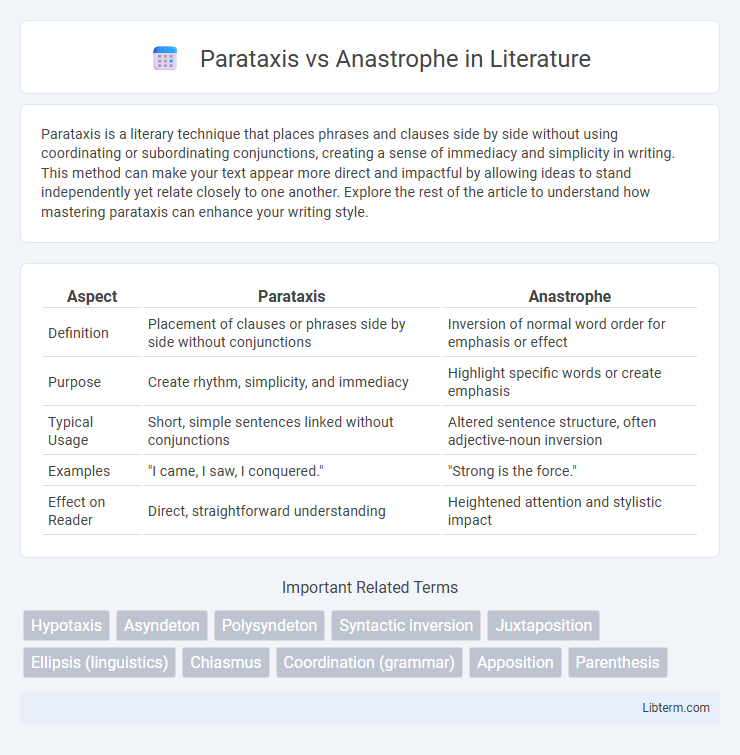Parataxis is a literary technique that places phrases and clauses side by side without using coordinating or subordinating conjunctions, creating a sense of immediacy and simplicity in writing. This method can make your text appear more direct and impactful by allowing ideas to stand independently yet relate closely to one another. Explore the rest of the article to understand how mastering parataxis can enhance your writing style.
Table of Comparison
| Aspect | Parataxis | Anastrophe |
|---|---|---|
| Definition | Placement of clauses or phrases side by side without conjunctions | Inversion of normal word order for emphasis or effect |
| Purpose | Create rhythm, simplicity, and immediacy | Highlight specific words or create emphasis |
| Typical Usage | Short, simple sentences linked without conjunctions | Altered sentence structure, often adjective-noun inversion |
| Examples | "I came, I saw, I conquered." | "Strong is the force." |
| Effect on Reader | Direct, straightforward understanding | Heightened attention and stylistic impact |
Introduction to Parataxis and Anastrophe
Parataxis involves placing clauses or phrases side by side without conjunctions, creating a straightforward, concise style that emphasizes clarity and immediacy in writing. Anastrophe, on the other hand, is a rhetorical device that inverts typical word order to highlight particular words or create emphasis, often enhancing poetic or dramatic effect. Both techniques manipulate sentence structure to influence rhythm and emphasis, with parataxis favoring simplicity and anastrophe introducing stylistic variation.
Defining Parataxis: Structure and Examples
Parataxis involves placing clauses or phrases side by side without subordinating conjunctions, creating a straightforward and concise sentence structure. Examples include simple sequences such as "I came, I saw, I conquered," where each clause holds equal syntactic importance. This structural choice enhances clarity and emphasizes each statement independently, often used in literature and rhetoric for dramatic effect.
Understanding Anastrophe: Meaning and Usage
Anastrophe is a rhetorical device involving the inversion of the typical word order in a sentence to create emphasis or a poetic effect, often placing the object before the subject or verb. Unlike parataxis, which links clauses or phrases side by side without conjunctions, anastrophe deliberately alters syntax to draw attention to specific words or ideas, enhancing stylistic impact in literature and speech. Commonly found in poetry and classical texts, anastrophe challenges conventional grammar rules to evoke vivid imagery and emotional resonance.
Key Differences Between Parataxis and Anastrophe
Parataxis involves placing clauses or phrases side by side without conjunctions, enhancing clarity and rhythm through simple, straightforward structure. Anastrophe reorders the conventional word sequence, often for emphasis or poetic effect, altering the natural syntactic arrangement. The key difference lies in parataxis focusing on the relationship and equality of clauses, while anastrophe targets word order manipulation within a single clause.
Historical Background and Origins
Parataxis, originating from ancient Greek rhetoric, involves placing clauses or phrases side by side without subordinating conjunctions, a style prevalent in Homeric epics and early biblical texts. Anastrophe, derived from the Greek term meaning "overturning" or "inversion," dates back to classical Latin and Greek poetry, where it was used to alter standard word order for emphasis or metrical purposes. Both figures of speech have deep roots in classical literature, shaping the syntax and expressive possibilities of Western languages over centuries.
Functions in Literary Contexts
Parataxis serves to create a rhythmic, straightforward narrative by placing clauses or phrases side by side without conjunctions, emphasizing simplicity and immediacy in literary contexts. Anastrophe disrupts conventional word order to highlight particular words or ideas, enhancing emphasis, tone, or mood through syntactic inversion. Both techniques function to manipulate reader perception--parataxis through coherence and directness, anastrophe through emphasis and stylistic distinctiveness.
Effects on Tone and Readability
Parataxis creates a straightforward, rhythmic tone by placing clauses or phrases side by side without conjunctions, enhancing clarity and quick comprehension. Anastrophe, by inverting the usual word order, introduces a more formal, poetic tone that can challenge readability but draws attention to specific words or concepts. Writers use parataxis to maintain simplicity and directness, while anastrophe emphasizes stylistic flair and nuance, impacting how readers interpret the text's mood and flow.
Parataxis and Anastrophe in Famous Works
Parataxis, the literary technique of placing clauses or phrases side by side without clear conjunctions, is prominently seen in Ernest Hemingway's "The Old Man and the Sea," where simple, direct sentences create a sense of immediacy and tension. Anastrophe, the deliberate inversion of normal word order, features famously in Shakespeare's "Macbeth," enhancing the dramatic effect and character voice, such as in the line "Fair is foul, and foul is fair." Both techniques serve to engage readers by altering natural syntax, with parataxis emphasizing straightforwardness and anastrophe adding poetic complexity.
Common Mistakes and Misinterpretations
Parataxis often faces misinterpretation when readers mistake it for simple listing rather than recognizing its role in creating rhythm and emphasis through coordinate clauses. Anastrophe is commonly mistaken for a mere poetic flourish, but its deeper purpose is to alter expected syntax to highlight specific words or invoke a particular tone. Confusing these two can lead to misreading a text's intended style, as parataxis thrives on straightforward juxtaposition, whereas anastrophe relies on intentional inversion for effect.
Practical Tips for Writers
Parataxis employs short, simple sentences or clauses placed side by side without conjunctions, creating a direct and impactful rhythm that enhances clarity and urgency in writing. Anastrophe involves the inversion of usual word order, which can add emphasis or a poetic tone but should be used sparingly to avoid confusing readers. Writers can effectively blend parataxis to maintain brisk pacing and anastrophe to highlight key ideas or evoke a stylistic flair.
Parataxis Infographic

 libterm.com
libterm.com